
Edinburgh
City
Formed 1928
Elected to Scottish Division Two 1931. Resigned 1949.
Promoted to SPFL League Two 2016
Kit History
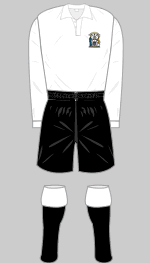
1928-circa 1932 d
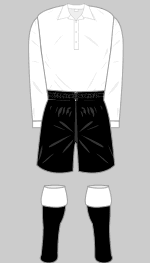
1932-1935 a d

1935-1936 b
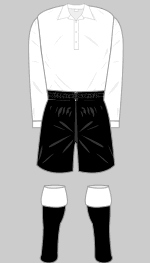
1936-Dec1937 c d
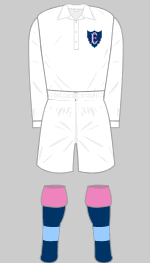
Jan-May 1938 d

1938-1955 e
Club continued to exist as Edinburgh City FC Ltd but did not field a team.
1955-1986
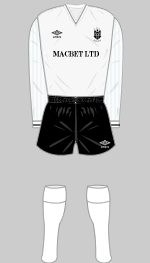
1986-1988 d
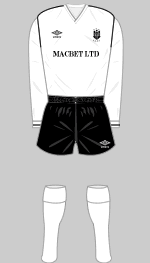
1988-1990 d
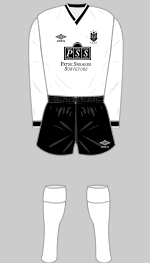
1990-1991 d
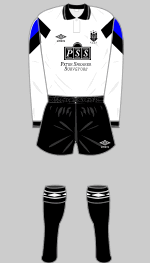
1991-1992 d
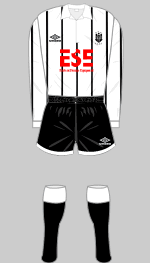
1993-1994 d
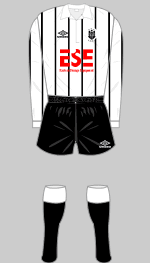
1994-1995 d
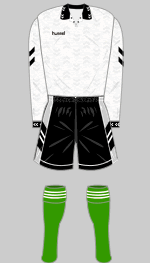
1995-1997 1 d
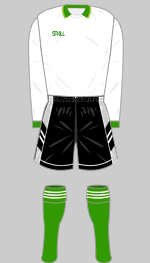
1995-1997 2 d
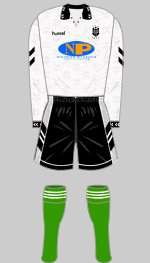
1997-1998 d
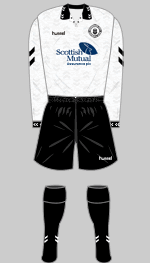
1998-1999 d
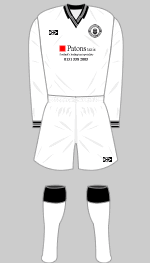
1999-2000 d
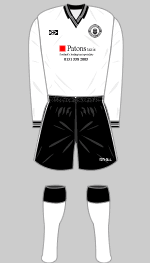
Aug-Sept 2000 d
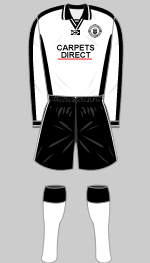
Sept-Nov 2000 d
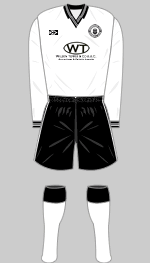
Nov 2000-2001 d
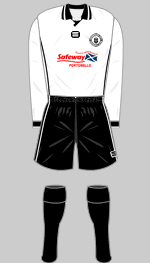
2001-2002 d
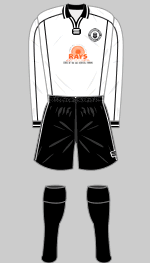
2002-2003 d
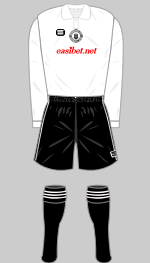
2003-2004 d
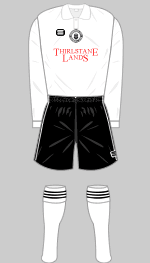
2004-2007 d
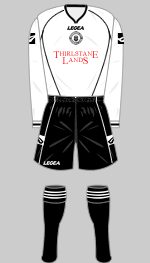
2007-2009 d f
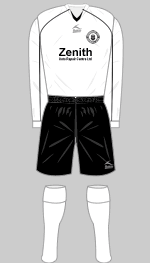
2009-2010 d
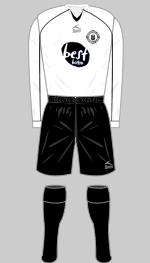
2010-2011 d
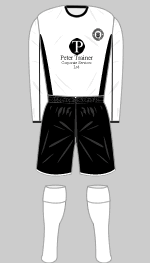
2011-Sept 2013 d f
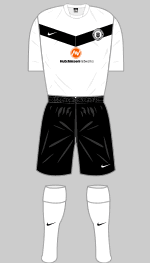
Sept-Oct 2013 d
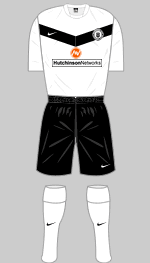
Oct 2013-2015 d f
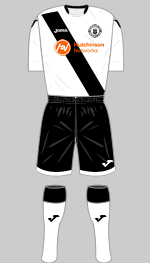
2015-2017 d f
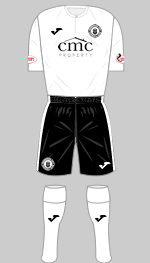
2017-2018 d
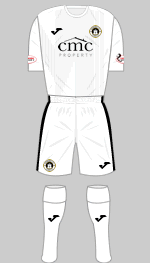
2018-2019 d
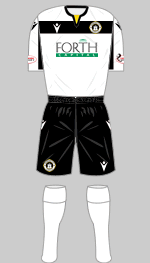
2019-2021 d
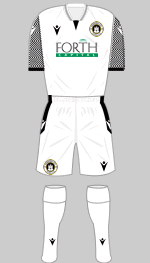
2021-2022 d
FC Edinburgh
2022
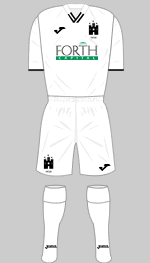
2022-2023 d
Background
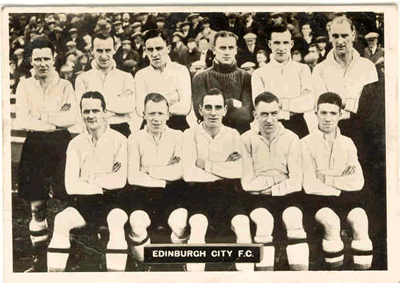 Formed in 1928, Edinburgh City set out
to emulate Queen's Park, competing at the higher levels of senior football
while remaining strictly amateur. After two seasons in the East of Scotland
League, they joined the Edinburgh & District League in 1930. The
following year the club was elected to the Second Division of the Scottish
League, replacing the original Clydebank FC. Doubts were expressed at
the time over whether Edinburgh could support a fifth side in the Scottish
Football League but the only other applicant was Nithsdale Wanderers,
a village side from Dumfrieshire that had been part of the ill-fated
Third Division.
Formed in 1928, Edinburgh City set out
to emulate Queen's Park, competing at the higher levels of senior football
while remaining strictly amateur. After two seasons in the East of Scotland
League, they joined the Edinburgh & District League in 1930. The
following year the club was elected to the Second Division of the Scottish
League, replacing the original Clydebank FC. Doubts were expressed at
the time over whether Edinburgh could support a fifth side in the Scottish
Football League but the only other applicant was Nithsdale Wanderers,
a village side from Dumfrieshire that had been part of the ill-fated
Third Division.
In their formative years the team wore the 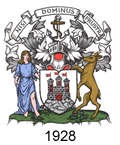 Edinburgh coat of arms on their shirts.
Edinburgh coat of arms on their shirts.
It soon became clear that the "Lilywhites" were going to struggle: they were forced to apply for re-election six times over the next eight seasons and it would have been seven had Bo'ness and Armadale not been expelled in 1932-33 and there was no re-election vote at the end of the season. Indeed, as Scotland was hit by recession, there were no clubs prepared to take the financial risk of joining the Scottish League and throughout the decade clubs applying for re-election were returned unopposed.
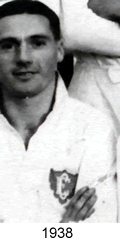 For a couple of months at the end of the 1937-38 season the team appears to have worn a white strip with unusual socks in navy, light blue and pink and a monogram crest. Alick Milne, HFK Research Associate and club director has found evidence that ties worn by officials at this time were in the club colours of Leander Pink, Oxford and Cambridge Blue.
For a couple of months at the end of the 1937-38 season the team appears to have worn a white strip with unusual socks in navy, light blue and pink and a monogram crest. Alick Milne, HFK Research Associate and club director has found evidence that ties worn by officials at this time were in the club colours of Leander Pink, Oxford and Cambridge Blue.
When the Second World War broke out, City played on in the Lothian Amateur League while retaining their membership of the SFL. When the Scottish League resumed in 1946, Edinburgh City were placed in the new Division C. Despite their poor pre-war performances, the club felt ill treated by this decision to relegate them to what was effectively a competition for reserve teams. Even at this lower level, City were out of their depth and in a twelve team league they finished 12th, 11th and 12th. Professionalism was reluctantly introduced in 1947 but without any noticeable impact on results. Riven by internal struggles, the club finally resigned in 1949.
After joining the Scottish Junior FA, for the next six seasons Edinburgh City played on in the Edinburgh & District Junior League where they seemed to be much more at home, finishing in comfortable mid-table positions. In 1955 the Edinburgh Corporation declined to renew the club's lease on City Park for reasons that remain obscure. The club ceased to field a team but continued to exist as a limited company and social club.
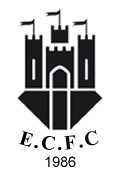 After a hiatus of 31 years, a proposal was put forward by Postal United FC (formed in 1966 and members of the East of Scotland League) to adopt the Edinburgh City name. The social club committee agreed and Postal United was legally incorporated into Edinburgh City Football Club Ltd in 1986. The team would now play in Edinburgh City's traditional white and black rather than Postal United's all-red. They continued to compete in the East of Scotland League, winning the title in 1996 and 2006.
After a hiatus of 31 years, a proposal was put forward by Postal United FC (formed in 1966 and members of the East of Scotland League) to adopt the Edinburgh City name. The social club committee agreed and Postal United was legally incorporated into Edinburgh City Football Club Ltd in 1986. The team would now play in Edinburgh City's traditional white and black rather than Postal United's all-red. They continued to compete in the East of Scotland League, winning the title in 1996 and 2006.
In 1995 Liberton Cropley AFC were thrown out of the Scottish Amateur FA for irregularities over player registration. Several "untainted" players and officials joined Edinburgh City who incorporated the amateur team's green colours into their first strip and from time to time wore their white change shirts as an alternate kit. Green was dropped in 1998 because some new committee members thought the team should not wear colours associated with the city's big teams, Hibernian and Hearts.
City had originally played on the Saughton Enclosure (ironically an unenclosed ground) on the west side of Edinburgh. They had three more homes before they moved into Meadowbank Stadium after Meadowbank Thistle moved to Livingston in 1996.
 At this stage they became full members of the Scottish FA and eligible to compete in the Scottish FA Cup. In 1997-98, they knocked SFL side East Stirlingshire out of the competition.
At this stage they became full members of the Scottish FA and eligible to compete in the Scottish FA Cup. In 1997-98, they knocked SFL side East Stirlingshire out of the competition.
City applied to join the Scottish Football League when vacancies arose in 2002 and 2008 but on both occasions other applicants were preferred.
In June 2013 the Scottish Premier League and Scottish Football League merged and a new competition, the Scottish Lowland Football League was formed which, along with the well-established Highland League, would form the fifth tier of Scottish football in a new pyramid structure. 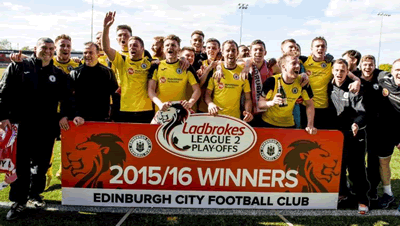 Edinburgh City successfully applied to join the Lowland League and won the competition in 2015 and 2016.
Edinburgh City successfully applied to join the Lowland League and won the competition in 2015 and 2016.
Under the new structure the champions of the two fifth tier competitions played off against each over two legs, the winner then meeting the last placed team from League Two for a place in the SPFL. In 2015 Edinburgh City were beaten by Brora Rangers at the first stage but the following year they won through to meet East Stirlingshire. After a 1-1 draw at Meadowbank, City scored from a penalty in the 87th minute of the return leg to become the first club ever to win promotion to the top levels of Scottish football.
After a lengthy consultation period, the City of Edinburgh Council began work to redevelop Meadowbank Stadium in the summer of 2017. The football club arranged to share Ainslie Park with Spartans FC for three 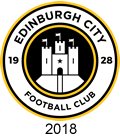 seasons while the works were undertaken.
seasons while the works were undertaken.
After a shaky start Edinburgh finished seventh in their inaugural season, ninth in 2017-18. A new look was 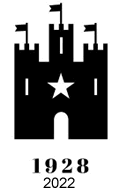 introduced for 2018-19 including an all-white strip and a new crest.
introduced for 2018-19 including an all-white strip and a new crest.
Success arrived in the 2021-22 season in which City finished fifth to qualify for the play-offs. They beat Dumbarton (from League One) in the semi finals and won the first leg of the final against Annan Athletic 2-0. In the return match Annan were 2-0 up after 20 minutes and the match was in the balance until Innes Murray scored the decisive goal eight minutes after half-time.
In June 2022 the club was rebranded as FC Edinburgh and a new crest was introduced.
Sources
- (a) Brian McColl
- (b) London Hearts
- (c) Historic Saints of Edinburgh (George Campbell 1983) provided by Stuart Swan.
- (d) Alick Milne (Director of Edinburgh City FC & HFK Research Associate)
- (e) The Scottish Football League Past Members (Norman Nichol 1994)
- (f) Donald Gellatly
Crests are the property of Edinburgh City FC